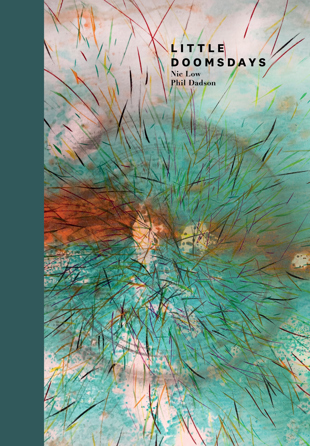The fifth in the kōrero series conceived and edited by Lloyd Jones, Little Doomsdays is a dynamic collaboration between artist Phil Dadson and Kāi Tahu writer Nic Low. Jessica Agoston-Cleary reviews it on Kete:
‘Sometimes, it’s the little things that are the heaviest, the most significant.
Nic Low and Phil Dadson’s Little Doomsdays is little, as far as art books go at least. At just 95 pages and weighing no more than a few hundred grams, the weight of the words and images contained within the smooth thick cover have weighed heavy on my heart and mind since cracking open cover and leafing through the pages. Heavier perhaps because of where I was when I immersed myself in this mysterious, maybe even mystical series of Little Doomsdays: thousands of feet above the earth, hurtling at hundreds of kilometers per hour between Melbourne and Sydney.
Looking up from the pages to gaze out the window at the shifting earth through the little Perspex window (windows I have always thought seem too impossibly fragile to withstand the pressure of flight), I was struck too many times to count by how similar Dadson’s images were to the vistas through the window. Even those of zoomed in, detailed abstraction looked as if somehow, Dadson had already seen what my eyes were seeing. This Sharman like ability to harness the very essence of things – from sound to moving image, to paint and even air itself, is what Dadson is known for. To have his artwork - most often contained within large, open, three-dimensional spaces - condensed, concentrated and contained within this little book is part of its magic, going some part of the way to explaining how it is that a thing so small almost bursts at the seams.
Dadson’s dynamic, earth energy infused works are laid out in direct opposition to Low’s Items. A series of rhymical, non-fiction poems-come-travel-logbook entry. Each item, expertly crafted and stripped back to the bare bones of requirement for a sentence, perfectly capture the fragility of life on earth and the role we humans play in tipping the balance. When it comes to doomsdays, there is no time for flowery, overly emotional language. The glare of reality and factually accurate recounting of events does not need embellishment. Yet, Low’s language is neither cold nor clinical. It is precisely and elegantly crafted, tapping into our a priori knowledge and just enough to invite us to colour in the background.’
Read the full review here.


